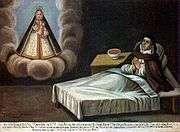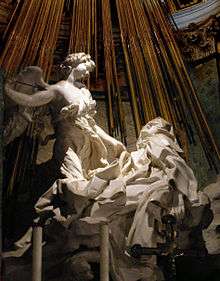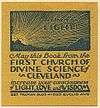Christian mysticism
Christian mysticism refers to mystical practices and theory within Christianity. Mysticism is not so much a doctrine as a method of thought.[1] It has often been connected to mystical theology, especially in the Catholic Church (including traditions from both the Latin Church and the Eastern Catholic Churches) and Orthodox Christianity (including traditions from both the Eastern Orthodox Church and Oriental Orthodoxy).
The attributes and means by which Christian mysticism is studied and practiced are varied. They range from ecstatic visions of the soul's mystical union with God and theosis (humans gaining divine qualities) in Eastern Orthodox theology to simple prayerful contemplation of Holy Scripture (i.e. Lectio Divina).
Etymology

"Mysticism" is derived from the Greek μυω, meaning "to conceal",[2] and its derivative μυστικός, mystikos, meaning 'an initiate'. In the Hellenistic world, a "mystikos" was an initiate of a mystery religion. "Mystical" referred to secret religious rituals[2] and use of the word lacked any direct references to the transcendental.[3]
In early Christianity the term mystikos referred to three dimensions, which soon became intertwined, namely the biblical, the liturgical and the spiritual or contemplative.[4] The biblical dimension refers to "hidden" or allegorical interpretations of Scriptures.[2][4] The liturgical dimension refers to the liturgical mystery of the Eucharist, the presence of Christ at the Eucharist.[2][4] The third dimension is the contemplative or experiential knowledge of God.[4]
Definition
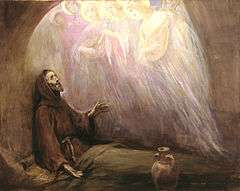
Presence
Bernard McGinn defines Christian mysticism as:
[T]hat part, or element, of Christian belief and practice that concerns the preparation for, the consciousness of, and the effect of [...] a direct and transformative presence of God.[5]
Presence versus experience
McGinn argues that "presence" is more accurate than "union", since not all mystics spoke of union with God, and since many visions and miracles were not necessarily related to union. He also argues that we should speak of "consciousness" of God's presence, rather than of "experience", since mystical activity is not simply about the sensation of God as an external object, but more broadly about
...new ways of knowing and loving based on states of awareness in which God becomes present in our inner acts.[5]
William James popularized the use of the term "religious experience" in his 1902 book The Varieties of Religious Experience.[6] It has also influenced the understanding of mysticism as a distinctive experience which supplies knowledge.[2]
Wayne Proudfoot traces the roots of the notion of "religious experience" further back to the German theologian Friedrich Schleiermacher (1768–1834), who argued that religion is based on a feeling of the infinite. The notion of "religious experience" was used by Schleiermacher to defend religion against the growing scientific and secular critique. It was adopted by many scholars of religion, of which William James was the most influential.[7]
Personal transformation

McGinn's emphasis on the transformation that occurs through mystical activity relates to this idea of "presence" instead of "experience":
This is why the only test that Christianity has known for determining the authenticity of a mystic and her or his message has been that of personal transformation, both on the mystic's part and—especially—on the part of those whom the mystic has affected.[5]
Other critics point out that the stress on "experience" is accompanied by favoring the atomic individual, instead of the shared life on the community. It also fails to distinguish between episodic experience, and mysticism as a process that is embedded in a total religious matrix of liturgy, scripture, worship, virtues, theology, rituals and practices.[8]
Richard King also points to disjunction between "mystical experience" and social justice:[9]
The privatisation of mysticism - that is, the increasing tendency to locate the mystical in the psychological realm of personal experiences - serves to exclude it from political issues as social justice. Mysticism thus becomes seen as a personal matter of cultivating inner states of tranquility and equanimity, which, rather than seeking to transform the world, serve to accommodate the individual to the status quo through the alleviation of anxiety and stress.[9]
Transformation has particular importance in the theology of Origen.(Trigg 2012)
Social constructionism
Mystical experience is not simply a matter between the mystic and God, but is often shaped by cultural issues. For instance, Caroline Bynum has shown how, in the late Middle Ages, miracles attending the taking of the Eucharist were not simply symbolic of the Passion story, but served as vindication of the mystic's theological orthodoxy by proving that the mystic had not fallen prey to heretical ideas, such as the Cathar rejection of the material world as evil, contrary to orthodox teaching that God took on human flesh and remained sinless.[10] Thus, the nature of mystical experience could be tailored to the particular cultural and theological issues of the time.
Development
The idea of mystical realities has been widely held in Christianity since the second century AD, referring not simply to spiritual practices, but also to the belief that their rituals and even their scriptures have hidden ("mystical") meanings.[5]
The link between mysticism and the vision of the Divine was introduced by the early Church Fathers, who used the term as an adjective, as in mystical theology and mystical contemplation.[3]
In subsequent centuries, especially as Christian apologetics began to use Greek philosophy to explain Christian ideas, Neoplatonism became an influence on Christian mystical thought and practice via such authors as Augustine of Hippo and Origen.
Greco-Judean influences
Jewish antecedents
Jewish spirituality in the period before Jesus was highly corporate and public, based mostly on the worship services of the synagogues, which included the reading and interpretation of the Hebrew Scriptures and the recitation of prayers, and on the major festivals. Thus, private spirituality was strongly influenced by the liturgies and by the scriptures (e.g., the use of the Psalms for prayer), and individual prayers often recalled historical events just as much as they recalled their own immediate needs.[11]
Of special importance are the following concepts:
- Binah (understanding) and Chokhmah (wisdom), which come from years of reading, praying and meditating the scriptures;
- Shekhinah, the presence of God in our daily lives, the superiority of that presence to earthly wealth, the pain and longing that come when God is absent; and the nurturing, feminine aspect of God;
- the hiddenness of God, which comes from our inability to survive the full revelation of God's glory and which forces us to seek to know God through faith and obedience;
- "Torah-mysticism", a view of God's laws as the central expression of God's will and therefore as worthy object not only of obedience but also of loving meditation and Torah study; and
- poverty, an ascetic value, based on the apocalyptic expectation of God's impending arrival, that characterized the Jewish people's reaction to being oppressed by a series of foreign empires.
In Christian mysticism, Shekhinah became mystery, Da'at became gnosis, and poverty became an important component of monasticism.[12]
Alexandria - Greek philosophy
The Alexandrian contribution to Christian mysticism centers on Origen and Clement of Alexandria. Clement was an early Christian humanist who argued that reason is the most important aspect of human existence and that gnosis (not something we can attain by ourselves, but the gift of Christ) helps us find the spiritual realities that are hidden behind the natural world and within the scriptures. Given the importance of reason, Clement stresses apatheia as a reasonable ordering of our passions in order to live within God's love, which is seen as a form of truth.[13] Origen, who had a lasting influence on Eastern Christian thought, further develops the idea that the spiritual realities can be found through allegorical readings of the scriptures (along the lines of Jewish aggadah tradition), but he focuses his attention on the Cross and on the importance of imitating Christ through the Cross, especially through spiritual combat and asceticism. Origen stresses the importance of combining intellect and virtue (theoria and praxis) in our spiritual exercises, drawing on the image of Moses and Aaron leading the Israelites through the wilderness, and he describes our union with God as the marriage of our souls with Christ the Logos, using the wedding imagery from the Song of Songs.[14] Alexandrian mysticism developed alongside Hermeticism and Neoplatonism and therefore share some of the same ideas, images, etc. in spite of their differences.[15]
Philo of Alexandria was a Jewish Hellenistic philosopher who was important for connecting the Hebrew Scriptures to Greek thought, and thereby to Greek Christians, who struggled to understand their connection to Jewish history. In particular, Philo taught that allegorical interpretations of the Hebrew Scriptures provides access to the real meanings of the texts. Philo also taught the need to bring together the contemplative focus of the Stoics and Essenes with the active lives of virtue and community worship found in Platonism and the Therapeutae. Using terms reminiscent of the Platonists, Philo described the intellectual component of faith as a sort of spiritual ecstasy in which our nous (mind) is suspended and God's Spirit takes its place. Philo's ideas influenced the Alexandrian Christians, Clement and Origen and through them, Gregory of Nyssa.[16]
Gospels
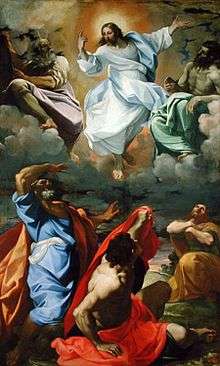
The Christian scriptures, insofar as they are the founding narrative of the Christian church, provide many key stories and concepts that become important for Christian mystics in all later generations: practices such as the Eucharist, baptism and the Lord's Prayer all become activities that take on importance for both their ritual and symbolic values. Other scriptural narratives present scenes that become the focus of meditation: the Crucifixion of Jesus and his appearances after his Resurrection are two of the most central to Christian theology; but Jesus' conception, in which the Holy Spirit overshadows Mary, and his Transfiguration, in which he is briefly revealed in his heavenly glory, also become important images for meditation. Moreover, many of the Christian texts build on Jewish spiritual foundations, such as chokhmah, shekhinah.[17]
But different writers present different images and ideas. The Synoptic Gospels (in spite of their many differences) introduce several important ideas, two of which are related to Greco-Judaic notions of knowledge/gnosis by virtue of being mental acts: purity of heart, in which we will to see in God's light; and repentance, which involves allowing God to judge and then transform us. Another key idea presented by the Synoptics is the desert, which is used as a metaphor for the place where we meet God in the poverty of our spirit.[18]
The Gospel of John focuses on God's glory in his use of light imagery and in his presentation of the Cross as a moment of exaltation; he also sees the Cross as the example of agape love, a love which is not so much an emotion as a willingness to serve and care for others. But in stressing love, John shifts the goal of spiritual growth away from knowledge/gnosis, which he presents more in terms of Stoic ideas about the role of reason as being the underlying principle of the universe and as the spiritual principle within all people. Although John does not follow up on the Stoic notion that this principle makes union with the divine possible for humanity, it is an idea that later Christian writers develop. Later generations will also shift back and forth between whether to follow the Synoptics in stressing knowledge or John in stressing love.[19]
In his letters, Paul also focuses on mental activities, but not in the same way as the Synoptics, which equate renewing the mind with repentance. Instead, Paul sees the renewal of our minds as happening as we contemplate what Jesus did on the Cross, which then opens us to grace and to the movement of the Holy Spirit into our hearts. Like John, Paul is less interested in knowledge, preferring to emphasize the hiddenness, the "mystery" of God's plan as revealed through Christ. But Paul's discussion of the Cross differs from John's in being less about how it reveals God's glory and more about how it becomes the stumbling block that turns our minds back to God. Paul also describes the Christian life as that of an athlete, demanding practice and training for the sake of the prize; later writers will see in this image a call to ascetical practices.[20]
Early church
The texts attributed to the Apostolic Fathers, the earliest post-Biblical texts we have, share several key themes, particularly the call to unity in the face of internal divisions and perceptions of persecution, the reality of the charisms, especially prophecy, visions and Christian gnosis, which is understood as "a gift of the Holy Spirit that enables us to know Christ" through meditating on the scriptures and on the Cross of Christ.[21] (This understanding of gnosis is not the same as that developed by the Gnostics, who focused on esoteric knowledge that is available only to a few people but that allows them to free themselves from the evil world.[22][23]) These authors also discuss the notion of the "two ways", that is, the way of life and the way of death; this idea has biblical roots, being found in both the Sermon on the Mount and the Torah. The two ways are then related to the notion of purity of heart, which is developed by contrasting it against the divided or duplicitous heart and by linking it to the need for asceticism, which keeps the heart whole/pure.[24][25] Purity of heart was especially important given perceptions of martyrdom, which many writers discussed in theological terms, seeing it not as an evil but as an opportunity to truly die for the sake of God—the ultimate example of ascetic practice.[26] Martyrdom could also be seen as symbolic in its connections with the Eucharist and with baptism.[27]
Desert Fathers
Inspired by Christ's teaching and example, men and women withdrew to the deserts of Sketes where, either as solitary individuals or communities, they lived lives of austere simplicity oriented towards contemplative prayer. These communities formed the basis for what later would become known as Christian monasticism. Mysticism is integral to Christian monasticism because the goal of practice for the monastic is union with God.
Monasticism
The Eastern church then saw the development of monasticism and the mystical contributions of Gregory of Nyssa, Evagrius Ponticus and Pseudo-Dionysius. Monasticism, also known as anchoritism (meaning "to withdraw") was seen as an alternative to martyrdom, and was less about escaping the world than about fighting demons (who were thought to live in the desert) and about gaining liberation from our bodily passions in order to be open to the Word of God. Anchorites practiced continuous meditation on the scriptures as a means of climbing the ladder of perfection—a common religious image in the Mediterranean world and one found in Christianity through the story of Jacob's ladder—and sought to fend off the demon of acedia ("un-caring"), a boredom or apathy that prevents us from continuing on in our spiritual training. Anchorites could live in total solitude ("hermits", from the word erēmitēs, "of the desert") or in loose communities ("cenobites", meaning "common life").[28]
Monasticism eventually made its way to the West and was established by the work of John Cassian and Benedict of Nursia. Meanwhile, Western spiritual writing was deeply influenced by the works of such men as Jerome and Augustine of Hippo.
Middle ages
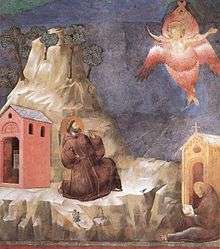
The Early Middle Ages in the West includes the work of Gregory the Great and Bede, as well as developments in Celtic Christianity and Anglo-Saxon Christianity, and comes to fulfillment in the work of Johannes Scotus Eriugena and the Carolingian Renaissance.
The High Middle Ages saw a flourishing of mystical practice and theorization corresponding to the flourishing of new monastic orders, with such figures as Guigo II, Hildegard of Bingen, Bernard of Clairvaux, the Victorines, all coming from different orders, as well as the first real flowering of popular piety among the laypeople.
The Late Middle Ages saw the clash between the Dominican and Franciscan schools of thought, which was also a conflict between two different mystical theologies: on the one hand that of Dominic de Guzmán and on the other that of Francis of Assisi, Anthony of Padua, Bonaventure, Jacopone da Todi, Angela of Foligno. Moreover, there was the growth of groups of mystics centered on geographic regions: the Beguines, such as Mechthild of Magdeburg and Hadewijch (among others); the Rhenish-Flemish mystics Meister Eckhart, Johannes Tauler, Henry Suso and John of Ruysbroeck; and the English mystics Richard Rolle, Walter Hilton and Julian of Norwich. This period also saw such individuals as Catherine of Siena and Catherine of Genoa, the Devotio Moderna, and such books as the Theologia Germanica, The Cloud of Unknowing and The Imitation of Christ.
Reformation
The Protestant Reformation downplayed mysticism, although it still produced a fair amount of spiritual literature. Even the most active reformers can be linked to Medieval mystical traditions. Martin Luther, for instance, was a monk who was influenced by the German Dominican mystical tradition of Eckhart and Tauler as well by the Dionysian-influenced Wesenmystik ("essence mysticism") tradition. He also published the Theologia Germanica, which he claimed was the most important book after the Bible and Augustine for teaching him about God, Christ, and humanity.[29] Even John Calvin, who rejected many Medieval ascetic practices and who favored doctrinal knowledge of God over affective experience, has Medieval influences, namely, Jean Gerson and the Devotio moderna, with its emphasis on piety as the method of spiritual growth in which the individual practices dependence on God by imitating Christ and the son-father relationship. Meanwhile, his notion that we can begin to enjoy our eternal salvation through our earthly successes leads in later generations to "a mysticism of consolation".[30]
Counter-reformation
But the Reformation brought about the Counter-Reformation and, with it, a new flowering of mystical literature, often grouped by nationality.
Spanish mysticism
The Spanish had Ignatius Loyola, whose Spiritual Exercises were designed to open people to a receptive mode of consciousness in which they can experience God through careful spiritual direction and through understanding how the mind connects to the will and how to weather the experiences of spiritual consolation and desolation;[31] Teresa of Ávila, who used the metaphors of watering a garden and walking through the rooms of a castle to explain how meditation leads to union with God;[32] and John of the Cross, who used a wide range of biblical and spiritual influences both to rewrite the traditional "three ways" of mysticism after the manner of bridal mysticism and to present the two "dark nights": the dark night of the senses and the dark night of the soul, during which the individual renounces everything that might become an obstacle between the soul and God and then experiences the pain of feeling separated from God, unable to carry on normal spiritual exercises, as it encounters the enormous gap between its human nature and God's divine wisdom and light and moves up the 10-step ladder of ascent towards God.[33] Another prominent mystic was Miguel de Molinos, the chief apostle of the religious revival known as Quietism. No breath of suspicion arose against Molinos until 1681, when the Jesuit preacher Paolo Segneri, attacked his views, though without mentioning his name, in his Concordia tra la fatica e la quiete nell' orazione. The matter was referred to the Inquisition. A report got abroad that Molinos had been convicted of moral enormities, as well as of heretical doctrines; and it was seen that he was doomed. On September 3, 1687 he made public profession of his errors, and was sentenced to imprisonment for life. Contemporary Protestants saw in the fate of Molinos nothing more than a persecution by the Jesuits of a wise and enlightened man, who had dared to withstand the petty ceremonialism of the Italian piety of the day. Molinos died in prison in 1696 or 1697.
Italy
Lorenzo Scupoli, from Otranto in Apulia was an Italian mystic best known for authoring The Spiritual Combat, a key work in Catholic mysticism.
France
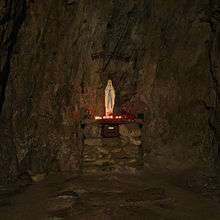
French mystics included Francis de Sales, Jeanne Guyon, François Fénelon, Brother Lawrence and Blaise Pascal.
England
The English had a denominational mix, from Catholic Augustine Baker and Julian of Norwich (the first woman to write in English), to Anglicans William Law, John Donne and Lancelot Andrewes, to Puritans Richard Baxter and John Bunyan (The Pilgrim's Progress), to the first "Quaker", George Fox and the first "Methodist", John Wesley, who was well-versed in the continental mystics.
An example of "scientific reason lit up by mysticism in the Church of England"[34]is seen in the work of Sir Thomas Browne, a Norwich physician and scientist whose thought often meanders into mystical realms, as in his self-portrait, Religio Medici, and in the "mystical mathematics" of The Garden of Cyrus, whose full running title reads, Or, The Quincuncial Lozenge, or Network Plantations of the ancients, Naturally, Artificially, Mystically considered. Browne's highly original and dense symbolism frequently involves scientific, medical, or optical imagery to illustrate a religious or spiritual truth, often to striking effect, notably in Religio Medici, but also in his posthumous advisory Christian Morals.
Browne's latitudinarian Anglicanism, hermetic inclinations, and Montaigne-like self-analysis on the enigmas, idiosyncrasies, and devoutness of his own personality and soul, along with his observations upon the relationship between science and faith, are on display in Religio Medici. His spiritual testament and psychological self-portrait thematically structured upon the Christian virtues of Faith, Hope and Charity, also reveal him as "one of the immortal spirits waiting to introduce the reader to his own unique and intense experience of reality".[35] Though his work is difficult and rarely read, he remains, paradoxically, one of England's perennial, yet first, "scientific" mystics.
Germany
Similarly well-versed in the mystic tradition was the German Johann Arndt, who, along with the English Puritans, influenced such continental Pietists as Philipp Jakob Spener, Gottfried Arnold, Nicholas Ludwig von Zinzendorf of the Moravians, and the hymnodist Gerhard Tersteegen. Arndt, whose book True Christianity was popular among Protestants, Catholics and Anglicans alike, combined influences from Bernard of Clairvaux, John Tauler and the Devotio moderna into a spirituality that focused its attention away from the theological squabbles of contemporary Lutheranism and onto the development of the new life in the heart and mind of the believer.[36] Arndt influenced Spener, who formed a group known as the collegia pietatis ("college of piety") that stressed the role of spiritual direction among lay-people—a practice with a long tradition going back to Aelred of Rievaulx and known in Spener's own time from the work of Francis de Sales. Pietism as known through Spener's formation of it tended not just to reject the theological debates of the time, but to reject both intellectualism and organized religious practice in favor of a personalized, sentimentalized spirituality.[37]
Pietism
This sentimental, anti-intellectual form of pietism is seen in the thought and teaching of Zinzendorf, founder of the Moravians; but more intellectually rigorous forms of pietism are seen in the teachings of John Wesley, which were themselves influenced by Zinzendorf, and in the teachings of American preachers Jonathan Edwards, who restored to pietism Gerson's focus on obedience and borrowed from early church teachers Origen and Gregory of Nyssa the notion that humans yearn for God,[38] and John Woolman, who combined a mystical view of the world with a deep concern for social issues; like Wesley, Woolman was influenced by Jakob Böhme, William Law and The Imitation of Christ.[39] The combination of pietistic devotion and mystical experiences that are found in Woolman and Wesley are also found in their Dutch contemporary Tersteegen, who brings back the notion of the nous ("mind") as the site of God's interaction with our souls; through the work of the Spirit, our mind is able to intuitively recognize the immediate presence of God in our midst.[40]
Mystic traditions
Eastern Christianity
Eastern Christianity has especially preserved a mystical emphasis in its theology[41] and retains a tradition of mystical prayer dating back to Christianity's beginnings.
Catholicism
The practice of Lectio Divina, a form of prayer that centers on scripture reading, was developed in its best-known form in the sixth century, through the work of Benedict of Nursia and Pope Gregory I, and described and promoted more widely in the 12th century by Guigo II. The 9th century saw the development of mystical theology through the introduction of the works of sixth-century theologian Pseudo-Dionysius the Areopagite, such as On Mystical Theology. His discussion of the via negativa was especially influential.
Protestantism
As part of the Protestant Reformation, theologians turned away from the traditions developed in the Middle Ages and returned to what they consider to be biblical and early Christian practices. Accordingly, they were often skeptical of Catholic mystical practices, which seemed to them to downplay the role of grace in redemption and to support the idea that human works can play a role in salvation, and which also seemed to come from post-biblical sources and practices. Thus, Protestant theology developed a strong critical attitude, oftentimes even an animosity towards Christian mysticism.[42] However, Quakers, Anglicans, Methodists, Episcopalians, Lutherans, Local Churches, Pentecostals and Charismatics have in various ways remained open to the idea of mystical experiences.[43]
Practice
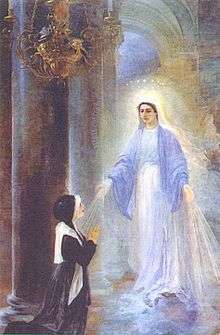
Historically, Christian mysticism has taught that for Christians the major emphasis of mysticism concerns a spiritual transformation of the egoic self, the following of a path designed to produce more fully realized human persons, "created in the Image and Likeness of God" and as such, living in harmonious communion with God, the Church, the rest of the world, and all creation, including oneself. For Christians, this human potential is realized most perfectly in Jesus, precisely because he is both God and human, and is manifested in others through their association with him, whether conscious, as in the case of Christian mystics, or unconscious, with regard to spiritual persons who follow other traditions, such as Gandhi. The Eastern Christian tradition speaks of this transformation in terms of theosis or divinization, perhaps best summed up by an ancient aphorism usually attributed to Athanasius of Alexandria: "God became human so that man might become god."[lower-alpha 1]
Threefold path
Going back to Evagrius Ponticus, Christian mystics have been described as pursuing a threefold path of purification, illumination and unification, corresponding to body (soma), soul (psyche), and spirit (pneuma). In 869, the 8th Ecumenical Council reduced the image of the human to only body and soul but within mystics a model of three aspects continued. The three aspects later became purgative, illuminative, and unitive in the western churches and prayer of the lips, the mind, the heart in the eastern churches.[44]
Purification
The first, purification is where aspiring traditionally Christian mystics start. This aspect focuses on discipline, particularly in terms of the human body; thus, it emphasizes prayer at certain times, either alone or with others, and in certain postures, often standing or kneeling. It also emphasizes the other disciplines of fasting and alms-giving, the latter including those activities called "the works of mercy," both spiritual and corporal, such as feeding the hungry and sheltering the homeless.
Purification, which grounds Christian spirituality in general, is primarily focused on efforts to, in the words of St. Paul, "put to death the deeds of the flesh by the Holy Spirit" (Romans 8:13). This is considered a result of the Spirit working in the person and is not a result of personal deeds. Also in the words of St. Paul, "...he who began a good work in you will carry it on to completion until the day of Christ Jesus." (Epistle to the Philippians 1:6). The "deeds of the flesh" here include not only external behavior, but also those habits, attitudes, compulsions, addictions, etc. (sometimes called egoic passions) which oppose themselves to true being and living as a Christian not only exteriorly, but interiorly as well. Evelyn Underhill describes purification as an awareness of one's own imperfections and finiteness, followed by self-discipline and mortification.[45] Because of its physical, disciplinary aspect, this phase, as well as the entire Christian spiritual path, is often referred to as "ascetic," a term which is derived from a Greek word which connotes athletic training. Because of this, in ancient Christian literature, prominent mystics are often called "spiritual athletes," an image which is also used several times in the New Testament to describe the Christian life. What is sought here is salvation in the original sense of the word, referring not only to one's eternal fate, but also to healing in all areas of life, including the restoration of spiritual, psychological, and physical health.
It remains a paradox of the mystics that the passivity at which they appear to aim is really a state of the most intense activity: more, that where it is wholly absent no great creative action can take place. In it, the superficial self compels itself to be still, in order that it may liberate another more deep-seated power which is, in the ecstasy of the contemplative genius, raised to the highest pitch of efficiency.
Illumination
The second phase, the path of illumination, has to do with the activity of the Holy Spirit enlightening the mind, giving insights into truths not only explicit in scripture and the rest of the Christian tradition, but also those implicit in nature, not in the scientific sense, but rather in terms of an illumination of the "depth" aspects of reality and natural happenings, such that the working of God is perceived in all that one experiences. Underhill describes it as marked by a consciousness of a transcendent order and a vision of a new heaven and a new earth.
Unification
The third phase, usually called infused or higher contemplation (or Mystical Contemplative Prayer[46]) in the Western tradition, refers to the experience of oneself as in some way united with God. The experience of union varies, but it is first and foremost always associated with a reuniting with Divine love, the underlying theme being that God, the perfect goodness,[47] is known or experienced at least as much by the heart as by the intellect since, in the words 1 John 4:16: "God is love, and he who abides in love abides in God and God in him." Some approaches to classical mysticism would consider the first two phases as preparatory to the third, explicitly mystical experience, but others state that these three phases overlap and intertwine.
Mystical Contemplative Prayer is the blessing for which the Christian mystic hopes. No human effort can produce it. This form of prayer has three characteristics. (a) It is infused (i.e. implanted by God in the soul, not the result of human effort.) (b) It is extraordinary (i.e. indicating that the intellect operates in new way). (c) Moreover, It is passive (i.e. showing that the soul receives something from God, and is conscious of receiving it.) It can manifest itself in one of four degrees. The four degrees are the prayer of quiet, the prayer of union, ecstatic union, and transforming deifying union.[46]
Underhill's five-stage path
Author and mystic Evelyn Underhill recognizes two additional phases to the mystical path. First comes the awakening, the stage in which one begins to have some consciousness of absolute or divine reality. Purgation and illumination are followed by a fourth stage which Underhill, borrowing the language of St. John of the Cross, calls the dark night of the soul. This stage, experienced by the few, is one of final and complete purification and is marked by confusion, helplessness, stagnation of the will, and a sense of the withdrawal of God's presence. This dark night of the soul is not, in Underhill's conception, the Divine Darkness of the pseudo-Dionysius and German Christian mysticism. It is the period of final "unselfing" and the surrender to the hidden purposes of the divine will. Her fifth and final stage is union with the object of love, the one Reality, God. Here the self has been permanently established on a transcendental level and liberated for a new purpose.[48]
Types of meditation
Within theistic mysticism two broad tendencies can be identified. One is a tendency to understand God by asserting what He is not and the other by asserting what He is. The former leads to what is called apophatic theology and the latter to cataphatic theology.
- Apophatic (imageless, stillness, and wordlessness) -- e.g., The Cloud of the Unknowing, Meister Eckhart; and
- Cataphatic (imaging God, imagination or words) -- e.g., The Spiritual Exercises of St. Ignatius of Loyola, Julian of Norwich, Francis of Assisi.[49]
Scholars such as Urban T. Holmes, III have also categorized mystical theology in terms of whether it focuses on illuminating the mind, which Holmes refers to as speculative practice, or the heart/emotions, which he calls affective practice. Combining the speculative/affective scale with the apophatic/cataphatic scale allows for a range of categories:[50]
- Rationalism = Cataphatic and speculative
- Pietism = Cataphatic and affective
- Encratism = Apophatic and speculative
- Quietism = Apophatic and affective
Ascetic practices
Many mystics, following the model of Paul's metaphor of the athlete, as well as the story of the disciples sleeping while Jesus prayed, disciplined their bodies through activities ranging from fasting and sleep-deprivation to more extreme forms, such as self-flagellation.
Sensory experiences
Many mystics experience visions. But other sensory experiences are common as well. For instance, Richard Rolle heard heavenly music and felt a fire in his chest.
Ecstasies
Religious ecstasy is common for many mystics, such as Teresa of Avila, whose experience was immortalized in the sculpture Ecstasy of Saint Teresa by Bernini.
Physical transformations
One of the most familiar examples of mystical physical transformation is the appearance of stigmata on the body of the mystic, such as those received by Francis of Assisi and Padre Pio. But other transformations are possible, such as the odour of sanctity that accompanies the body of the deceased mystic, such as Teresa of Avila and Therese of Liseaux.
Miracles
Some mystics are said to have been able to perform miracles. But for many mystics, the miracles occurred to them. In the Middle Ages, one common form of mystical miracle, especially for women, was the Eucharistic miracle, such as being able to eat nothing other than the communion host. Catherine of Genoa was an example of someone who experienced this type of miracle.
Influential Christian mystics and texts
Greek influences
The influences of Greek thought are apparent in the earliest Christian mystics and their writings. Plato (428–348 BC) is considered the most important of ancient philosophers, and his philosophical system provides the basis of most later mystical forms. Plotinus (c. 205 – 270 AD) provided the non-Christian, neo-Platonic basis for much Christian, Jewish and Islamic mysticism.[51]
Early Christians
- Justin Martyr (c. 105 – c. 165) used Greek philosophy as the stepping-stone to Christian theology. The mystical conclusions that some Greeks arrived at, pointed to Christ. He was Influenced by: Pythagoras, Plato, Aristotle as well as Stoicism.
- Origen (c. 185 – 254): On Principles, Against Celsus. Studied under Clement of Alexandria, and probably also Ammonius Saccus (Plotinus' teacher). He Christianized and theologized neo-Platonism.
- Athanasius of Alexandria (c. 296/8 – 373) - The Life of Antony (c. 360)[52]
- Gregory of Nyssa (c. 335 – after 394): Focused on the stages of spiritual growth, the need for constant progress, and the "divine darkness" as seen in the story of Moses.
- Augustine (354 – 430): De Trinitate, Confessions. Important source for much mediaeval mysticism. He brings Platonism and Christianity together. Influenced by: Plato and Plotinus.
- Pseudo-Dionysius the Areopagite (c. 500) - Mystical Theology
Middle Ages and Renaissance
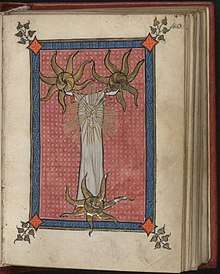
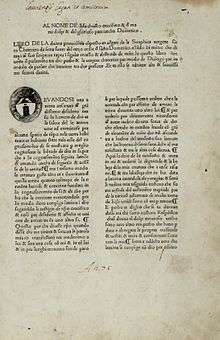
- John Scotus Eriugena (c. 810 – c. 877): Periphyseon. Eriugena translated Pseudo-Dionysius from Greek into Latin. Influenced by: Plotinus, Augustine, Pseudo-Dionysius.
- Bernard of Clairvaux (1090 – 1153): Cistercian theologian, author of The Steps of Humility and Pride, On Loving God, and Sermons on the Song of Songs; strong blend of scripture and personal experience.
- Hildegard of Bingen (1098 – 1179): Benedictine abbess and reformist preacher, known for her visions, recorded in such works as Scivias (Know the Ways) and Liber Divinorum Operum (Book of Divine Works). Influenced by: Pseudo-Dionysius, Gregory the Great, Rhabanus Maurus, John Scotus Eriugena.
- Victorines: fl. 11th century; stressed meditation and contemplation; helped popularize Pseudo-Dionysius; influenced by Augustine
- Hugh of Saint Victor (d.1141): The Mysteries of the Christian Faith, Noah's Mystical Ark, etc.
- Richard of Saint Victor (d.1173): The Twelve Patriarchs and The Mystical Ark (e.g. Benjamin Minor and Benjamin Major). Influenced Dante, Bonaventure, Cloud of Unknowing.
- Franciscans:
- Francis of Assisi (c.1182 - 1226): founder of the order, stressed simplicity and penitence; first documented case of stigmata
- Anthony of Padua (1195 - 1231): priest, Franciscan friar and theologian; visions; sermons
- Bonaventure (c.1217 - 1274): The Soul's Journey into God, The Triple Way, The Tree of Life and others. Influenced by: Pseudo-Dionysius, Augustine, Bernard, Victorines.
- Jacopone da Todi (c. 1230 – 1306): Franciscan friar; prominent member of "The Spirituals"; The Lauds
- Angela of Foligno (c.1248 - 1309): tertiary anchoress; focused on Christ's Passion; Memorial and Instructions.
- Thomas Aquinas (1225 – 1274): priest, Dominican friar and theologian.
- Beguines (fl. 13th century):
- Mechthild of Magdeburg (c.1212 - c.1297): visions, bridal mysticism, reformist; The Flowing Light of the Godhead
- Hadewijch of Antwerp (13th century): visions, bridal mysticism, essence mysticism; writings are mostly letters and poems. Influenced John of Ruysbroeck.
- Rhineland mystics (fl. 14th century): sharp move towards speculation and apophasis; mostly Dominicans
- Meister Eckhart (1260 - 1327): sermons
- Johannes Tauler (d.1361): sermons
- Henry Suso (c.1295 - 1366): Life of the Servant, Little Book of Eternal Wisdom
- Theologia Germanica (anon.). Influenced: Martin Luther
- John of Ruysbroeck (1293 – 1381): Flemish, Augustinian; The Spiritual Espousals and many others. Similar themes as the Rhineland Mystics. Influenced by: Beguines, Cistercians. Influenced: Geert Groote and the Devotio Moderna.
- Catherine of Siena (1347 - 1380): Letters
- The English Mystics (fl. 14th century):
- Anonymous - The Cloud of the Unknowing (c. 1375)—Intended by ascetic author as a means of instruction in the practice of mystic and contemplative prayer.
- Richard Rolle (c.1300 - 1349): The Fire of Love, Mending of Life, Meditations on the Passion
- Walter Hilton (c.1340 - 1396): The Ladder of Perfection (a.k.a., The Scale of Perfection) -- suggesting familiarity with the works of Pseudo-Dionysius (see above), the author provides an early English language seminal work for the beginner.
- Julian of Norwich (1342 - c.1416): Revelations of Divine Love (a.k.a. Showing of Love)
Renaissance, Reformation and Counter-Reformation
- Ignatius of Loyola (1491–1556): St. Ignatius had a number of mystical experiences in his life, the most significant was an experience of enlightenment by the river Cardoner, in which, he later stated, he learnt more in that one occasion than he did in the rest of his life. Another significant mystical experience was in 1537, at a chapel in La Storta, outside Rome, in which he saw God the Father place him with the Son, who was carrying the Cross. This was after he had spent a year praying to Mary for her to place him with her Son (Jesus), and was one of the reasons why he insisted that the group that followed his 'way of proceeding' be called the Society of Jesus.[53]
- Teresa of Ávila (1515–1582): Two of her works, The Interior Castle and The Way of Perfection, were intended as instruction in (profoundly mystic) prayer based upon her experiences. Influenced by: Augustine.
- John of the Cross (Juan de Yepes) (1542–1591): Wrote three related instructional works, with Ascent of Mount Carmel as a systematic approach to mystic prayer; together with the Spiritual Canticle and the Dark Night of the Soul, these provided poetic and literary language for the Christian Mystical practice and experience. Influenced by and collaborated with Teresa of Ávila.
- Joseph of Cupertino (1603-1663): An Italian Franciscan friar who is said to have been prone to miraculous levitation and intense ecstatic visions that left him gaping.[54]
- Jakob Böhme (1575-1624): German theosopher; author of The Way to Christ.
- Thomas Browne (1605-1682): English physician and philosopher, author of Religio Medici.
- Brother Lawrence (1614–1691): Author of The Practice of the Presence of God.
- Isaac Ambrose (1604-1664): Puritan, author of Looking Unto Jesus.
- Angelus Silesius (1624 – 1677): German Catholic priest, physician, and religious poet.
- George Fox (1624–1691): Founder of the Religious Society of Friends.
- Madame Jeanne Guyon (1648-1717): Visionary and Writer.
- William Law (1686–1761): English mystic interested in Jakob Böhme who wrote several mystical treatises.
- Emanuel Swedenborg (1688-1772): Influential and controversial Swedish writer and visionary.
Modern era
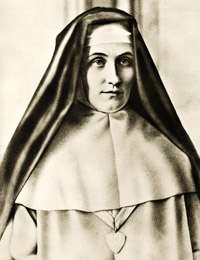
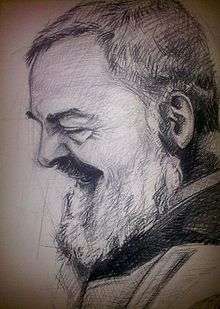
- Domenico da Cese (1905-1978): Stigmatist Capuchin monk.
- Maria Valtorta (1898-1963): Visionary and writer.
- Mary of Saint Peter (1816–1848): Carmelite nun.
- Marie Lataste (1822–1899): Visionary, nun and writer.
- Andrew Murray (1828-1917): Evangelical Missionary and Writer, Author of over 240 books.
- Marie Martha Chambon (1841–1907): Nun and visionary.
- Marie Julie Jahenny (1850–1941): Stigmatist.
- Rudolf Steiner (1861–1925): Founder of the Anthroposophical Society, Bio-dynamics, Waldorf Education, Threefold Social Order, Eurythmy, writer.
- Mary of the Divine Heart Droste zu Vischering (1863–1899): Sister of the Good Shepherd.
- Frank Laubach (1884–1970): Evangelical missionary, author of Letters by a Modern Mystic.
- Padre Pio of Pietrelcina (1887–1968): Friar, priest, stigmatic.
- Sadhu Sundar Singh (1889–1929): Evangelical Indian missionary, ascetic.
- Maria Pierina de Micheli (1890–1945): Visionary.
- Thomas Raymond Kelly (1893–1941): Quaker.
- Alexandrina of Balazar (1904–1955): Writer.
- Dag Hammarskjöld (1905-1961): Swedish diplomat (Second Secretary General of the United Nations). His posthumously published spiritual diary "Vägmärken" (Markings) gave him the reputation of having been one of the few mystics in the political arena.
- Mary Faustina Kowalska (1905–1938): Polish nun and visionary.
- Eugenia Ravasio (1907–1990): Italian nun and visionary of God the Father.
- Simone Weil (1909-1943): French writer, political activist and ecstatic visionary.
- Flower A. Newhouse (1909-1994): American clairvoyant.
- Carmela Carabelli (1910–1978): Italian writer.
- Pierina Gilli (1911–1991): Italian visionary.
- A. W. Tozer (1897-1963): Christian and Missionary Alliance; author of The Pursuit of God.
- Thomas Merton (1915–1968): Trappist monk and writer.
- Watchman Nee (1903-1972): Visionary and Writer.
- Witness Lee (1905-1997): Local Churches Visionary and Writer, Author of over 400 books.
- Sister Lúcia (1907-2005): Portuguese participant in the 1917 Fátima apparitions, nun, and prophetess.
- Bernadette Roberts (1931–2017): Carmelite nun and writer, focusing on no-self states.
- Richard J. Foster (1942-): Quaker theologian; author of Celebration of Discipline and Prayer.
- James Goll (1952-): charismatic writer and prophet; author of Wasted on Jesus and The Seer.
- Mike Bickle (1955-): charismatic writer and pastor; author of Growing in the Prophetic and Growing in Prayer.
See also
- Bridal theology
- Christian mysticism in ancient Africa
- List of Christian mystics
- Christian mythology
- Christian views on astrology
- Esoteric Christianity
- Gnosiology
- Jesus Prayer
- Kenosis
- Open theism
- Pauline mysticism
- Quietism (Christian philosophy)
- Salvation (Christianity)
- Soteriology
- Theosophy
- Chaplet of the Holy Spirit and His Seven Gifts
References
Notes
- Literally, "God became man so that man might become god." Here, man is understood as human and no debate exists within the Church concerning a contrary interpretation.
Citations
- Jacobs & Haas 1899, p. 334.
- Gellman 2011.
- Parsons 2011, p. 3.
- King 2002, p. 15.
- McGinn 2006.
- Hori 1999, p. 47.
- Sharf 2000, p. 271.
- Parsons 2011, p. 4-5.
- King 2002, p. 21.
- Bynum 1987, pp. 64, 253.
- Barton 1986, pp. 47-57.
- Holmes 2002, p. 15.
- Holmes 2002, pp. 25-26.
- Holmes 2002, pp. 26-28.
- Holmes 2002, pp. 23-25.
- Holmes 2002, p. 16.
- Holmes 2002, pp. 14-16.
- Holmes 2002, p. 17.
- Holmes 2002, pp. 19-20.
- Holmes 2002, pp. 18-19.
- Healey 1999, p. 2.
- Healey 1999, pp. 8-9.
- Holmes 2002, pp. 20-21.
- Healey 1999, pp. 3-4.
- Holmes 2002, p. 21.
- Healey 1999, pp. 4-6.
- Holmes 2002, p. 22.
- Holmes 2002, pp. 29-31.
- Holmes 2002, pp. 125-127.
- Holmes 2002, pp. 127-128.
- Holmes 2002, pp. 94-97.
- Holmes 2002, pp. 98-99.
- Holmes 2002, pp. 99-102.
- Sencourt 1925, p. 126.
- Huxley 1929.
- Holmes 2002, pp. 136-137.
- Holmes 2002, pp. 136-138.
- Holmes 2002, pp. 138-139.
- Holmes 2002, pp. 139-140.
- Holmes 2002, pp. 143-144.
- Lossky 1976.
- Cornuz 2003, p. 149.
- Fremantle 1964.
- Holmes 2002, p. 37.
- Underhill 1911, p. 198, Part II, Ch. 3.
- Lehodey 1982.
- Anon. 1857.
- Greene 1987, pp. 22-38.
- McBrien 1995, p. 901.
- Holmes 2002, pp. 4–5.
- Janz 2009.
- Schaff 1892, p. 194.
- "Life of St. Ignatius - Founder of the Society of Jesus". Loyola Jesuit College. Archived from the original on 2011-02-11. Retrieved 2011-04-18.
- Pastrovicchi 1918.
- Chasle 1906.
- Kelly 2009, pp. 79, 86.
Sources
- Anon. (1857). Theologia Germanica: Which Setteth Forth Many Fair Lineaments of Divine Truth, and Saith Very Lofty and Lovely Things Touching a Perfect Life. Translated by Susanna Winkworth. Andover: W.F. Draper.CS1 maint: ref=harv (link)
- Barton, John (1986). "The Old Testament". In Jones, Cheslyn; Wainwright, Geoffrey; Yarnold, Edward (eds.). The Study of Spirituality. Oxford: University Press.CS1 maint: ref=harv (link)
- Bynum, Caroline Walker (1987). Holy Feast and Holy Fast: The Religious Significance of Food to Medieval Women. University of California Press. ISBN 978-0-520-06329-7.CS1 maint: ref=harv (link)
- Chasle, Louis (1906), Sister Mary of the Divine Heart, Droste zu Vischering, religious of the Good Shepherd, 1863–1899, London: Burns & OatesCS1 maint: ref=harv (link)
- Cornuz, Michel (2003). Le protestantisme et la mystique: entre répulsion et fascination [Protestantism and mysticism: between repulsion and fascination] (in French). Labor et Fides. ISBN 978-2-8309-1097-1.CS1 maint: ref=harv (link)
- Fremantle, Anne Jackson (1964). The Protestant Mystics. Little, Brown.CS1 maint: ref=harv (link)
- Gellman, Jerome (Summer 2011). "Mysticism". In Zalta, Edward N. (ed.). The Stanford Encyclopedia of Philosophy.CS1 maint: ref=harv (link)
- Greene, Dana (Spring 1987). "Adhering to God: The Message of Evelyn Underhill for Our Times". Spirituality Today. Vol. 39. pp. 22–38.CS1 maint: ref=harv (link)
- Healey, Charles J. (1999). Christian Spirituality: An Introduction to the Heritage. Alba House. ISBN 978-0-8189-0820-0.CS1 maint: ref=harv (link)
- Holmes, Urban Tigner (2002). A History of Christian Spirituality: An Analytical Introduction. Church Publishing. ISBN 978-0-8192-1914-5.CS1 maint: ref=harv (link)
- Hori, Victor Sogen (1999), "Translating the Zen Phrase Book" (PDF), Nanzan Bulletin, 23
- Huxley, J.S. (1929). Religion without revelation:. Harper and Brothers.CS1 maint: ref=harv (link)
- Jacobs, Henry Eyster; Haas, John Augustus William (1899). The Lutheran Cyclopedia. Scribner. p. 334.CS1 maint: ref=harv (link)
- Janz, Bruce B. (2009). "Who's Who in the History of Western Mysticism". Archived from the original on 2011-07-27. Retrieved 2010-11-30.CS1 maint: ref=harv (link)
- Kelly, Elizabeth M. (2009). The Rosary: A Path into Prayer. Loyola Press. ISBN 978-0-8294-3068-4.CS1 maint: ref=harv (link)
- King, Richard (2002), Orientalism and Religion: Post-Colonial Theory, India and "The Mystic East", Routledge
- Lehodey, Domitry V. (1982). The Ways of Mental Prayer. Tan. ISBN 978-0-89555-178-8.CS1 maint: ref=harv (link)
- Lossky, Vladimir (1976). The Mystical Theology of the Eastern Church. St Vladimir's Seminary Press. ISBN 978-0-913836-31-6.CS1 maint: ref=harv (link)
- McBrien, Richard P., ed. (1995). "Mysticism". The HarperCollins Encyclopedia of Catholicism. San Francisco: HarperCollins. ISBN 978-0-06-065338-5.CS1 maint: ref=harv (link)
- McGinn, Bernard (2006), The Essential Writings of Christian Mysticism, New York: Modern Library
- Parsons, William B. (2011), Teaching Mysticism, Oxford University Press
- Pastrovicchi, Angelo (1918). St. Joseph of Copertino. B. Herder.CS1 maint: ref=harv (link)
- Schaff, Philip (1892). "The Life of Antony". A Select library of Nicene and post-Nicene fathers of the Christian church Second Series. Vol. IV. New York: The Christian Literature Company.CS1 maint: ref=harv (link)
- Sencourt, Robert (1925). Outflying philosophy: a literary study of the religious element in the poems and letters of John Donne and in the works of Sir Thomas Browne and of Henry Vaughan the Silurist, etc. Simpkin, Marshall, Hamilton, Kent.CS1 maint: ref=harv (link)
- Sharf, Robert H. (2000). "The Rhetoric of Experience and the Study of Religion" (PDF). Journal of Consciousness Studies. 7 (11–12): 267–87. Archived from the original (PDF) on 2013-05-13. Retrieved 2013-05-10.
- Trigg, Joseph W. (2012). Origen. The Early Church Fathers. London and New York: Routledge. ISBN 978-1-134-81525-8.CS1 maint: ref=harv (link)
- Underhill, Evelyn (1911). Mysticism: A Study in Nature and Development of Spiritual Consciousness. London: Methuen.CS1 maint: ref=harv (link)
Further reading
- Tito Colliander: Way of the Ascetics, 1981, ISBN 0-06-061526-5
- Samuel Fanous and Vincent Gillespie, eds. The Cambridge Companion to Medieval English Mysticism, Cambridge University Press, 2011
- Richard Foster: Celebration of Discipline: The Path to Spiritual Growth, 1978, ISBN 0-06-062831-6
- Kathleen Lyons: Mysticism and Narcissism. Cabbridge Scholars, 2016, ISBN 978-1-4438-8043-5
- Cheslyn Jones, Geoffrey Wainwright and Edward Yarnold, eds.: The Study of Spirituality, Oxford University Press, 1986, ISBN 0-19-504170-4
- Bernard McGinn: The Foundations of Mysticism: Origins to the Fifth Century, 1991, reprint 1994, ISBN 0-8245-1404-1
- Bernard McGinn: The Growth of Mysticism: Gregory the Great through the 12th Century, 1994, paperback ed. 1996, ISBN 0-8245-1628-1
- Tarjei Park, The English Mystics, SPCK, 1998, ISBN 0-281-05110-0
- Thomas E. Powers: Invitation to a Great Experiment: Exploring the Possibility that God can be Known, 1979, ISBN 0-385-14187-4
- Ryan Stark, "Some Aspects of Christian Mystical Rhetoric, Philosophy, and Poetry," Philosophy & Rhetoric 41 (2008): 260–77.
- William Thiele: "Monks in the World: Seeking God in a Frantic Culture", 2014, ISBN 978-1-62564-540-1
- Evelyn Underhill: The Spiritual Life: Four Broadcast Talks, Hodder & Stoughton, 1937, x, 141 p.
External links
| Wikisource has the text of the 1913 Catholic Encyclopedia article Mysticism. |
| Wikibooks has a book on the topic of: Mysticism |
